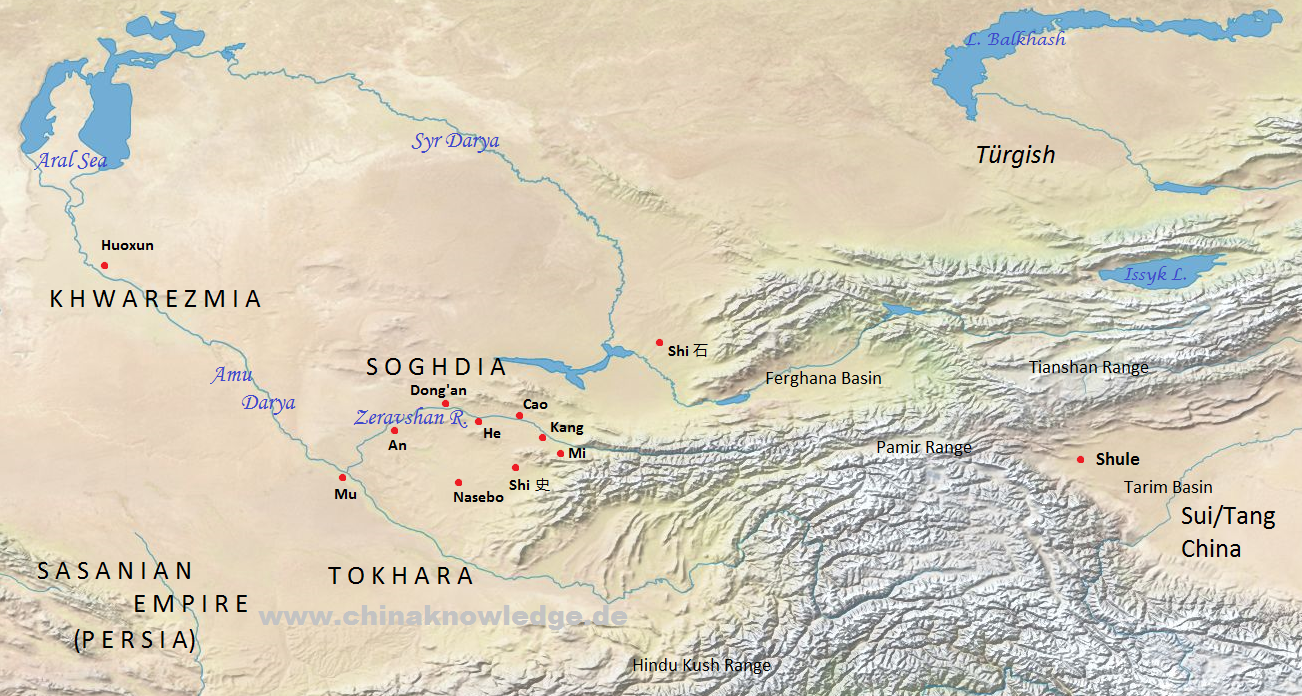The state of Huoxun 火尋 was located on the lower course of the River Amu Darya, near modern Urganch in Uzbekistan, a land formerly known as Soghdia or Soghdiana, in Chinese Sute 粟特 (by the Greeks as Transoxania). Legend holds that the city was founded by one of the Nine Barbarian Tribes from Zhaowu (jiuxing hu 九姓胡 or Zhaowu jiuxing 昭武九姓). The Roman geographer Strabo called it Khorasmia, i.e. Khwārazm, or Khwarezmia (Chinese transcription Hualazimu 花剌子模, or Hulumushi 忽魯木石). In Chinese sources of the Han period 漢 (206 BCE-220 CE), the place is known with the name Huanqian 驩潛, during the Northern Wei period 北魏 (386-534) as Husimi 呼似密, and in later sources as Huoliximijia 貨利習彌伽, Huoliximi 貨利習彌, Guoli 過利, or Huocimi 火辭. 彌.
 |
The Soghdia around 600 CE. Based on Tan Qixiang 譚其驤, ed. (1995), Zhongguo lishi ditu ji 中國歷史地圖集, Vol. 5, Sui, Tang, Wudai Shiguo shiqi 隋唐五代十國時期 (Beijing: Zhongguo ditu chubanshe, 1996). |
The country was located in the lower reaches of River Amu Darya, and its capital city was either called Aojian 奧鞬 or Yulonggechi 玉龍格赤 (which might be another transcription of the native name Khwarezm). Among the states of the Nine Zhaowu tribes, it did not play an important role. In 712 it was conquered by Muslim invaders.
The state of Khwarezm was founded in 996, but became a tributary state of the Seljuk Empire (Chinese transcription Sai'erzhu 塞爾柱) in 1043. A year later the Western Liao empire 西遼 (1124-1211) defeated the Seljuks, and Khwarezm became a subject to the Western Liao. In the late 11th century Khwarezm won strength again under Ala ad-Din Tekish (1172-1200) and his son Ala ad-Din Muhammad II (1200-1220), and Khwarezm conquered parts of Persia (under the Ghaznavid dynasty), the eastern parts of the Abbasid Caliphate (today's Iraq), Khorasan (in NE Persia) and Afghanistan.
Činggis Qaɣan sent in 1218 a trade envoy of more than 400 persons to the Khwarezmian city of Otrar (Chinese: Edala 訛答刺), but Mohammad II ordered to kill the merchants. This was the pretext for the Mongols to invade and subdue the region. Khwarezm became part of the Ilkhan Empire. In the 14th century Central Asia was wholly transformed by Turkish culture, and suffered greatly under the assails by Tamerlane.